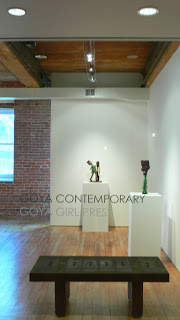Joyce Scott’s newest exhibition, ‘Painful Death/ Painless Life’ is not for the faint of heart. Underneath the gaudy, bedazzled surfaces and bright shiny colors, there is smoldering rage. You sense this immediately and are forced to decide: Do I implicate myself? Do I open myself up to this raw experience, or do I stay safely at a distance? The world that Scott has stitched and beaded together is not a safe or a comfortable one, however, it does reward the careful viewer with juicy morsels of truth and enlightenment, tucked into beautiful adornment.
Joyce Scott’s impeccable craftsmanship with materials once considered ‘mere’ craft draws the viewer in like a bee to honey. Blown glass figurines, beaded dolls, and assembled beaded ‘worlds’ are all highly believable and relevant under Scott’s steady hand. There are no seams, no editing glitches, and the work is spaced out beautifully and breathes in the space. This work effortlessly straddles the line between kitchy outsider art and sophisticated social critique. Scott makes it all look easy and understated by burying her content in glistening surfaces.
I have to admit that, as a white woman from a middle-class background, I feel slightly at a loss, surrounded by Scott’s work. Sure, I’ve read my share of Tony Morrison and Alice Walker, but Scott’s persona is more visceral and more confusing. These works can’t be put aside and bookmarked – these are real, confrontational entities with a palpable sense of power and rage. I want to feel a sense of kinship, I want to feel included, but I don’t. They make me feel like an outsider and this makes me uncomfortable.
Like the vulnerable and pink relief sculpture, “Tanzanian Flayed Albino Man’s Face and Penis,” I feel raw and naked encountering many of Scott’s works. In this particular case, I am moved to empathy for someone (or something) but am not exactly sure who or what. There is a sense of dignity in weakness, as well as the resignation of the oppressed. On so many levels, this sculpture is alarming, disquieting, and, strangely, adorable. One senses the artist’s personal identification with many of these figures, simultaneously powerful and vulnerable, grotesque and familiar.
 In ‘Day After Rape Darfur I,’ Scott uses recent history as a metaphor, transforming terror and violence into a barbie-sized figure. From a distance, this piece is almost cute – perched daintily on a small shelf. When you come in for a closer look, your eye goes right to the iridescent red beads fanning out from the figure’s rear end. For a split second you think, ‘Oh aren’t they pretty!’ and then the disgust hits. This is the key to the power in these works – the viewer is attracted to their physical, formal characteristics and that this attraction somehow makes us complicit in their horrific and violent message.
In ‘Day After Rape Darfur I,’ Scott uses recent history as a metaphor, transforming terror and violence into a barbie-sized figure. From a distance, this piece is almost cute – perched daintily on a small shelf. When you come in for a closer look, your eye goes right to the iridescent red beads fanning out from the figure’s rear end. For a split second you think, ‘Oh aren’t they pretty!’ and then the disgust hits. This is the key to the power in these works – the viewer is attracted to their physical, formal characteristics and that this attraction somehow makes us complicit in their horrific and violent message.
If these works were merely educational and were accurate in their historical detail, they wouldn’t fool us into liking them. The fact that we DO like them brings us face to face with ourselves as individuals and societies. Scott’s beaded and assembled sculptures posess an inherent conflict – on one side you sense the artist’s loving hand, while, on the other, you see the world as a heartbreak, a tragedy.
In several of Scott’s sculptures, you gain a sense of the artist’s dark sense of humor as well. In “Look Mom – A Doctor,” Scott’s sly, irreverent laugh skewers her own peers along with the rest of the world. A light-skinned African-American woman strolls proudly on the arm of her ‘solid’ and dark professional man – an African sculpture that Scott repainted with a doctor’s coat. This woman functions as a pathetic stereotype for all women who want their men to support them, and for all the people who choose their relationships for superficial reasons, but you can’t hate this figure because she’s so damn lively and proud. Scott has done it again – made you aware of your own prejudices and desires, but she doesn’t make it easy.
Joyce Scott’s “Painful Death/ Painless Life” is anything but painless, but she somehow makes us not mind. This is a masterful and complex show, wildly colorful and even joyful, while mourning deep wounds. Joyce Scott’s view is unflinchingly harsh, but also manages to be tender and loving in surprising ways. I feel threatened and challenged by these works as a result, but am also attracted and intrigued.
Comfort is over-rated anyway. According to Leo Buscaglia, American Guru, “The person who risks nothing, does nothing, has nothing, is nothing, and becomes nothing. He may avoid suffering and sorrow, but simply cannot learn and feel and chance and grow and love and live.” Joyce Scott has the courage and the inspiration to live with suffering and sorrow, and her work takes us along for the ride.




